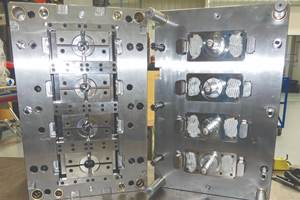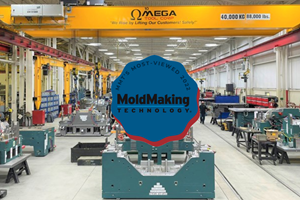Jeffrey Dininger: Educator Extraordinaire
Years of mold design and engineering come full circle as an expert teaches his craft.
During his career, Jeffrey Dininger has worn many hats in the moldmaking industry and recently winning the Mold Designer of the Year 2002 award from the Society of Plastics Engineers (SPE) (Brookfield, CT) Moldmaking and Mold Design Division is proof positive that his work has - and will continue to - impact his peers for many years to come.
Currently a manufacturing engineer and training coordinator for the Injection Molding Training Program at Sandusky, OH-based Visteon Automotive Systems (formerly part of Ford Motor Co.), Dininger boasts 14 years of experience in the instruction of plastics processing with his major focus on injection molding; instruction in the design of plastic products; and the design of plastic injection molds, investment casting molds, jigs and machining fixtures for the aircraft, aerospace and automotive industries. Before that, he spent nine years in process engineering, six years in project engineering and four years in injection mold design.
History Lesson
Originally from Tiffin, OH, Dininger presently resides in Litchfield, OH with his wife of 20 years. A father of four, he started out in the industry while attending Bowling Green State University (Bowling Green, OH), where he earned a B.S. in Education in Technology. "I worked in the plastics department at Whirlpool Corp. during the summers," he recalls. "When I had a tumor removed from the inside of my spinal column, I went back to school at Akron Machining Institute and learned injection mold design, When I graduated, I went to North Coast Tool and Mold (Brooklyn Heights, OH) and designed injection molds and investment casting molds."
Later, he ventured into education, falling back on that degree he earned at Bowling Green. "I taught Injection Mold Design at the Akron Machining Institute for several years," Dininger notes. "Then, I was in charge of and taught the Plastics Processing Program at Lorain County Community College." Additionally, he has served on the Education Committee for Society of Plastics Engineers (National and Cleveland Section) and on the advisory committee for SPE's Plastics Technician's Toolbox.
Dininger has been with Visteon for seven years, although he has been instructing/consulting for them for more than 10 years. His responsibilities include the following:
- Process optimization for headlamp, taillight and multicolor lighting departments.
- Molding machine tuning and optimization.
- Review tooling and tooling designs for feasibility and process capability for optimal processing and the manufacture of highly visible, cosmetic plastic parts.
- Process troubleshooting of difficult critical processing problems - ones that will shut down assembly plants within a matter of hours.
- Review of new products for the feasibility of tooling and manufacturability.
- Serve as a liaison between the advanced injection molding engineering group, the production management and the production floor.
- Introduce and coordinate implementation of new high-tech technologies including writing acceptance performance criteria for this equipment and writing purchase orders.
- Serve as a liaison between new model engineering, tooling engineering, the tooling standards group, and the production management and floor personnel.
- Train and coordinate the training of setup personnel from the production floor.
- Perform experiments and correct long-term processing problems.
Eventually, Dininger plans to get involved with SPE's Moldmaking and Design Division and Injection Molding Division. "I would like to work with an SPE committee on standardizing terms used for injection molding troubleshooting so that the entire industry can benefit," he states. "Right now I am involved in a project of defining what a process capable mold is for our organization, and then how to test it."
In conclusion, he offers the following advice to his peers. "Injection molding - along with many other plastic processes - is a complex process and needs to be well understood to make the process be profitable for you," he states. "This means that you must understand each component of the business in depth and practice that understanding in order to have a profitable business in this field. This includes training all of your setup personnel, floor engineers, floor supervisors, middle management, upper management, tool builders, product engineers, tooling engineers and materials engineers." Sounds like it worked for him!
Mold Designer Of the Year Award
Each year, the Moldmaking and Mold Design Division of the Society of Plastics Engineers (Brookfield, CT) looks for award recipients for its two awards: Mold Designer of the Year and Moldmaker of the Year. Potential recipients are solicited through the division's newsletter, ballots, trade publications, etc.
The awards - sponsored by D-M-E and Progressive Components respectively - give each winner $500, which will be donated on their behalf to a technical school of their choice. The following information briefly outlines the criteria for the awards:
Candidates for Nomination:
- Is or was a moldmaker/mold designer.
- Has made a contribution to the industry, and is active in trade societies, training and in establishing industry policies, etc.
- Has strong technical experience.
- Has a reputation for conducting business in a fair and honest manner.
- Does not have to be an SPE member.
- A brief bio should also be forwarded about the candidate detailing his/her accomplishments.
All candidates are reviewed by SPE's board. Please visit its website at www.4spe.org for more information. ![]()
Related Content
True Five-Axis Machine Yields More Throughput, Greater Productivity
CDM Tool & Mfg. Co. LLC increased shop capacity thanks to a versatile high-speed/high-accuracy five-axis Fooke mill capable of cutting very large workpieces quickly and accurately with fewer setups.
Read MoreLaser Welder Yields Fast, Precise Mold Repair
Intralox's integration of the Alpha Laser ALFlak has significantly improved their tool room efficiency when it comes to difficult welds and urgent repairs.
Read MorePrecision Welding Services Offer Rapid Turnaround Mold Repair and Reduced Molder Downtime
X-Cell Tool & Mold relies on outsourced, high-quality welding repairs from Lewis-Bawol Welding to ensure its customers' molds are back in production quickly and affordably.
Read MoreAdvances in P20 Steel Potentially Eliminates Need for Stress Relieving After Rough Cutting
Omega Tool Corp. compares conventional, new P20 grades side by side in production fascia tools, finds no downside.
Read MoreRead Next
How to Use Strategic Planning Tools, Data to Manage the Human Side of Business
Q&A with Marion Wells, MMT EAB member and founder of Human Asset Management.
Read MoreReasons to Use Fiber Lasers for Mold Cleaning
Fiber lasers offer a simplicity, speed, control and portability, minimizing mold cleaning risks.
Read MoreHow to Use Continuing Education to Remain Competitive in Moldmaking
Continued training helps moldmakers make tooling decisions and properly use the latest cutting tool to efficiently machine high-quality molds.
Read More







.jpg;maxWidth=300;quality=90)













